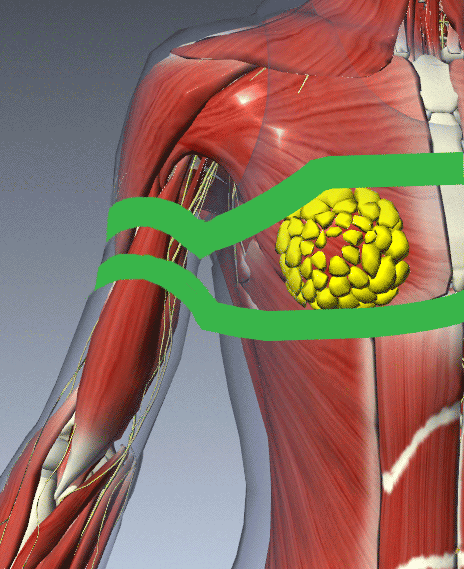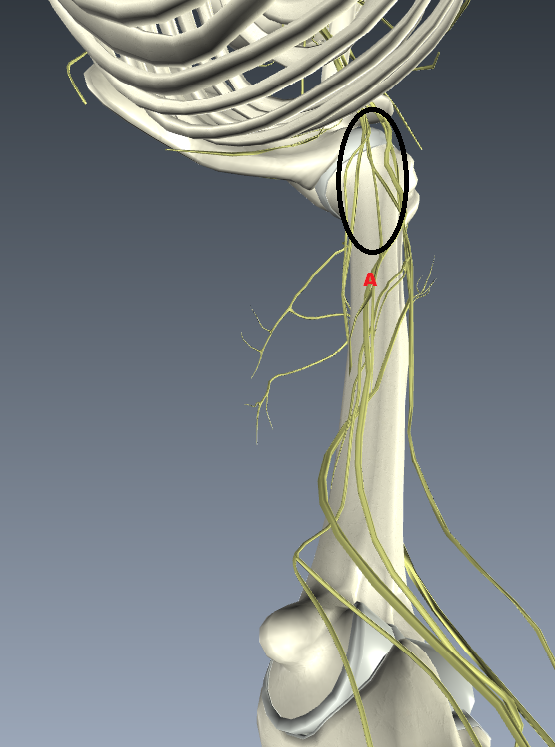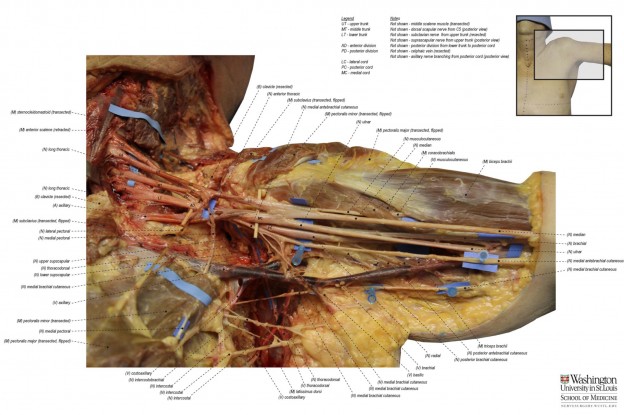Safety & common mistakes
The most common mistake in tying gote shibari?
 A= Radial B=Ulnar |
|
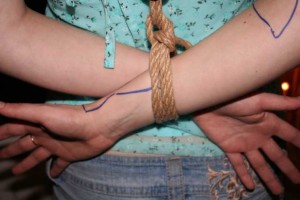 Note: Insufficient wrist tie slack |
I recently ran intermediate and advanced courses in which I taught the standard OS TK (actually more correctly called a 'gote or 'gote shibari as it does not exhibit the typical 'high hand' position) and revised the tie with those who professed to know it. Almost all of those who already had a good idea of how to complete the steps, and many of those who were taught from scratch, were leaving insufficient safety space at the wrists. In the main, I believe this is because force of habit makes people treat it like any other single column tie where being able to slide a finger or two under the binding is sufficient slack. The wrist tie here is a special case since it is not designed to restrain but merely to support the forearms in a parallel position, provide the foundation for thestem and retain the original shape of the tie. The idea is to prevent the arms dropping into and X-shape, which destroys the shape and tends to tighten the wrist tie. In the example shown below, the wrists are in the 'facing backwards' position that seems to be common in Japan. Whilst they have dropped and tightened the binding, it is still well away from the danger points.
There is no need to make this tight as the two torso/arm wraps do this job by preventing the arms being moved outwards and the wrists being withdrawn from the binding. Thus, around double the safety space would be my recommendation. The benefit of the additional safety space is twofold.
Firstly, it helps to prevent excessive pressure on the binding due to the loading of the harness during suspension. As the load is placed on the main line, the wraps will move away from the body thus adding tension on the main stem, which obviously begins at the wrists. Thus, the wrists will be drawn upwards out of parallel into more into an 'X' so increasing the pressure on the lower and upper sides of the wrists. This effect will be greater with lower wrap tension since the bindings will be allowed to move further from the body creating what Osada Steve refers to as 'melon space', i.e. a gap large enough to pass a melon through. The tension on the OS/Kinoko TK is critical for this reason; like the porridge in 'Goldilocks and the Three Bears', it needs to be just right. The wraps tend to be tied fairly firmly so there is not a great deal of movement away from the body.
Of course, all gotes are not designed the same. For example, Arisue appears to tie his TKs less snugly, so the wraps pull away more. The reason he shows a gote with the forearms dropped out of parallel in his Five Rings series could well be to allow for the effect. I shall try to get an answer from him on this.
If wrists are placed with inner sides together, as seems to the current thinking in the west, the radial nerve on one wrist (Point A) might be in contact with the bindings. Of course, as I have pointed out elsewhere, the Japanese tendency to place wrists with the inner sides facing back leaves the, in my opinion, less vulnerable ulnar nerve on the lower side (Point B).
Secondly, more slack allows the model more flexibility to change wrist positions should discomfort, circulation issues or pressure on a nerve become a problem.
When checking students' wrist ties, I noticed that a tight binding can bring the knot securing it dangerously close to a nerve vulnerability on the upper side of the wrist. Whilst I need to conduct a wider survey, it appears that a lot of people, including me, are very sensitive where the nerve crosses the prominent bone at the end of the forearm on the thumb side. I suspect that many injuries are caused by the knot or rope trapping the nerve against this bone, which lies about 1cm (less than ½") up the forearm from the 'snuff box', i.e. the depression in the joint itself, where we are usually taught that the main vulnerability exists. I will post some photos to clarify this location and a video illustrating the following test. One can generally locate this spot by gently tapping around this area with the side of a finger. When you hit it, you will feel a typical nerve tingle that might extend down thumb and first two fingers. I would strongly recommend that you find this spot on anyone you tie. This will help you avoid it and also familiarise the person tied with what to look out for. Susceptibility to nerve damage is a massive variable. Some people are almost invulnerable under normal circumstances, whilst others have less favourably routed or protected paths. Pro bondage models will fall into the former category as those who are less 'bomb-proof' will soon be discouraged by injuries of this type. Electric Fairie is an example of the latter, in five years of hard play and shows, not one injury. Nina/fiammi also appears to exhibit no obvious radial sensitivity at the wrist but rope won't end up near there as she has no problem grabbing the opposite upper arm in a t-k position.
I believe the flexibility of the model is an important factor in minimising the risk of nerve injury at the wrist. If one has reduced movement that prevents one getting the wrists beyond the binding, the chance of nerve compression increases since the rope will be forced into the danger spot. This improvised tie illustrates what I mean. This tie has only been selected to show the wrist position…yes, I know it is not a takate-kote, or even a recognised Japanese tie, the wrists are tied too tight and that cinching the wrist is very bad practice for that tie
![]()
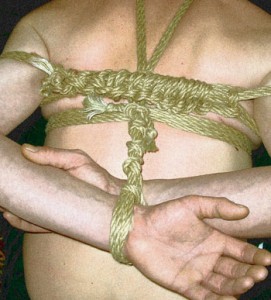 Limited flexibility. Note: A double column not recommended here |
|
 Good flexibility |
You can see that, unlike a pro bondage model, his limited flexibility means he cannot get both wrists away from the binding, consequently the rope is on the ulnar on both wrists. IMHO, this is better than wrists together for him since the radial, which I believe to be more vulnerable, is not on the more heavily loaded underside. However, I believe his inability to get each hand well up the opposite forearm places him at greater risk. By comparison, here is the sort of position that is typical of what is easily achieved by a bondage model, the tie is nowhere near the wrists. Things like this are why they are pro models and can emerge unscathed from extreme suspensions and hard shows.
Many of these girls already engage in physically demanding activities at a high level, e.g. dance, silks/aerial, gymnastics. If you are not a light-weight, super fit, ultra-flexible youngster with iron-clad nerve paths, some ties might beyond your safety limits so bear this in mind. Of course, most performers are also highly skilled professionals who know just how far they can go, so a lot of what you see at this level is very much a case of “Don't try this at home, kiddies!". Sadly, westerners seem to believe everyone can do everything and quite a few are getting hurt trying. However, the Japanese pros are working with a very limited number of very experienced models and tend to shy away from anything more than undemanding bondage with others. However, even they are not immune from injury and some nawashi have gained an unenviable record of nerve problems.
Nerve compression often only provokes minimal warning signs, so it is vital to listen to your body and tell the rigger immediately. All too often, victims of nerve damage have ignored these signs thinking that such a slight sensation is insignificant. Safe suspension requires team-work, skill and working within ones limitations. The feedback from the person tied is vital as not even uber-doms or rope gods will know their body as well as they do. Their well-being is always more important than protocol or D/s rules, it is one instance where even the lowest slave or submissive should speak up regardless.
Box-ties, gotes, TK's and nerves: Tying too low?
As you might recall, I questioned the old “
Mind the Gap" rule of safer rope placement ('The Gap' is the dip between the muscles on the outside of my arm above the red dot in the right hand image below) some while ago after blindly believing it myself for many years. I'm now convinced that, whilst it might lead to good placement, its reasoning is flawed. I'm not sure where the myth that the main radial nerve spiraled around in 'The Gap' originated but it seems to be one that I and some other notable authors swallowed, hook, line and sinker. I can only apologise for perpetuating what appears to be an internet myth. It is a relief to know that whilst the biological reasoning seems misguided, my advice to place the wraps a couple of fingers width apart either side of 'The Gap' was sound. It certainly appears from my 'Easy rule of thumb for wrap placement?' thread in my Fetlife Kinbaku group that field reports support it and avoiding the lower half of the upper arm is a smart move generally.
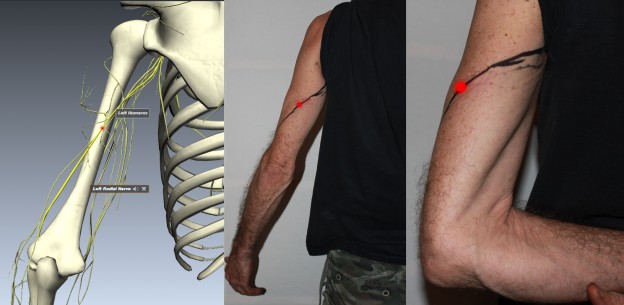
It is a medical fact that the radial usually spirals around much lower than 'The Gap' in the normal individuals. Therefore, in most people, the main branch is not in 'The Gap'. Thus, I speculate that the wraps are unlikely to damage it in a side or face down suspension using this sort of tie! Although, it is possible with some people that face up suspensions might carry a higher risk since some load might be on the back of the arm where the radial lies. The good thing about the rule is that if you place your wraps on the slope of the muscle each side of 'The Gap', so quite close to each other, you are likely to have optimal placement for
most people most of the time. True, there is a cutaneous branch running under the deltoid but I have yet to hear of an issue with this. If any of my readers have heard different, please let me know. Meanwhile, I'm assuming it is sufficiently protected not to be of concern. Osada Steve told me he generally favoured high close wraps and had never caused a radial nerve problem. That is no guarantee it will work in every case.
The 3-part image above shows a 3D representation in the first frame. We palpated and marked the path of my radial nerve, which seems a bit higher than many people's, in the next two photos. The red dot shows how an arbitrarily chosen spot moves as the arm is rotated into box-tie position. As you can see, the nerve twists more to the outside. It is crucial to appreciate how the position is changed from standard medical position that is the norm in most representations that are to be found when searching the net. You can see the main branch does not run into 'The Gap', although the 3D diagram shows the sensory ancillary branch on the outside. I was very pleased to have this confirmed when a prominent hand and upper limb surgeon, and avid rigger, used these pictures to support a presentation at LFAJRB. He has also produced photos of the path marked on the bone which reflect my findings. He said typically the nerve is likely to spiral around between the mid-point and 10-12cm above the outermost point at the bottom of the humerus. Thus, this would appear to be the area to avoid.

|
|
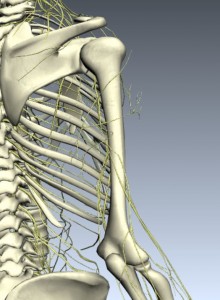
|
How come we never figured out the path better? My suspicion is that we failed to check the so-called 'facts' that were circulating, misinterpreted medical diagrams or didn't take account of how different things are with the arms folded behind for the tie compared to standard medical position. We should always check our 'facts', especially those learned from the internet. Everyone can be a self-proclaimed expert with their own blog or site nowadays. Not only that, but we need to also be aware that even accepted scientific facts change. Don't forget that how many of those have changed even in a few decades, never mind from one century to another.
Here are just a few scientific myths of the past and some more recent. Of course, on a more mundane level, those of us who have failed to defrost food sufficiently in a microwave oven will wonder why the myth that they heat food from the inside persists when they find the centre icy and crunchy ![]()
Even old illustrations like this one from Gray's Anatomy clearly show that the main nerve is on the inside, not the outside, of the upper arm at 'The Gap' level. In other words, it is vulnerable roughly where the upper cinches might run. This is a highly vulnerable area for the radial and care should always be taken not to create bulk here that might compress the nerve. It usually curves to the outside somewhere below the mid-point of the arm and it is in this sector that the nerve is likely to be vulnerable on the outside to pressure from the lower wrap (see 3D image below, Path of radial nerve).
I suspect that many riggers, in a misguided effort to 'Mind the Gap', place their wraps too far apart. The consequence of this is that the lower wrap ends up below the mid-point, exactly where you don't want it, assuming you intend to go above the radial nerve. This is not to say that low bottom wraps are inevitably a problem. In an unloaded gote that is not tied ridiculously tight, running over the radial is unlikely to cause injury unless an undue susceptibility exists, in my opinion. It might also be possible to place the bottom wrap below the radial thus missing the vulnerable area if your partner's nerve spirals around higher than average. Of course, to do this, you need to trace their nerve path. Rules of thumb are all very well but they are no substitute for knowing where the nerve runs on the person you are tying and acting on their feedback. This might be how some people are apparently tying very low get away with it but this is merely speculation in my part. How rope placement feels and exactly where it sits will change every time you tie, what works for them one day, might not on another. It's vital for the person being tied to be aware of the slightest warning signs, to give feedback and the rigger to respond fast. At the first twinge, get the load off. In suspensions, this means getting at least one leg down to provide support. Releasing wrists also allows the arms to drop and tension to be released.
Path of radial nerve
The signs pf a compromised nerve are unusual sensations running down the arm to the fingers. If you feel twinges or electric-like feelings, however slight, running down to the thumb and first two fingers, odds on its your radial expressing its displeasure at being tweaked. Take note and don't ignore it, act fast! It might be a whispered warning which will not be repeated. If you feel sudden pain associated with rope movement, it could already be too late as it could indicate a torn nerve. In that case, the damage is done and it is a matter of time before your body joins it up again to resume function. If sudden pain is felt without loss of function or feeling, it is unlikely to be a nerve causing the problem.
I've heard people checking nerves by getting their partner to make a fist or grip their hand. This is useless for checking for radial injury. There are two types of damage depending on the function of the injured branch: Motor, effecting movement, and sensory providing sensation. If the former is injured you experience a degree of paralysis, whilst the latter will result in numbness. Often, both types will be affected.
The squeeze or fist test will tell you nothing about compression of a sensory branch since this will only result in sensation loss/numbness of thumb and first two fingers. If the only symptom is numbness, it is likely the injury occurred in the forearm or wrist. As I have said before
here, the main culprit here is an overly tight wrist binding compressing the nerve on the thumb side. Restricting your partner's ability to shift arm position can also have the knock-on effect of not allowing them to move out of a dangerous position. This is something canny models often do. The pro's get hurt less often not only because their rigger knows their body, and what they can do with it, but because they do as well and listen to its warnings. That said, they are like anyone at the top of their profession: well-suited to the job. This usually means being almost bomb-proof in the nerve department. In some cases, trying to emulate them might be beyond us mere mortals ![]() If you have ever seen what Vlada can get away with doing with Falco, you'll understand what I mean! It's not for nothing that we nick-named him 'Superman'. From a personal investigation, his radial seems insensitive in the inside upper arm even with the sort of vigorous prodding that would have most of us jumping sky high.
If you have ever seen what Vlada can get away with doing with Falco, you'll understand what I mean! It's not for nothing that we nick-named him 'Superman'. From a personal investigation, his radial seems insensitive in the inside upper arm even with the sort of vigorous prodding that would have most of us jumping sky high.
The classic test for radial motor nerve damage is an inability raise the thumb (thumb extension). Wrist drop is odds on a symptom of damage to the motor branch in the upper arm. Likely sites of injury are the upper cinch area on the inside of the upper arm or the lower wraps on the outside below the mid-point.
The 3D diagram below shows the radial nerve in standard medical position. The Top Marker A is the bony bit on the outside of your shoulder, D is the Bottom Marker which is the protuberance on the end of your upper arm bone (humerus). B is a point mid-point between A and D. C is around 10-12cm (about 4-4.75″) above D. The radial is likely to be vulnerable between points C and D, i.e within the rectangular box, but more specifically it is likely to be between B and C. This is not an immutable law,
you might be different. The only way to know for sure is to check.
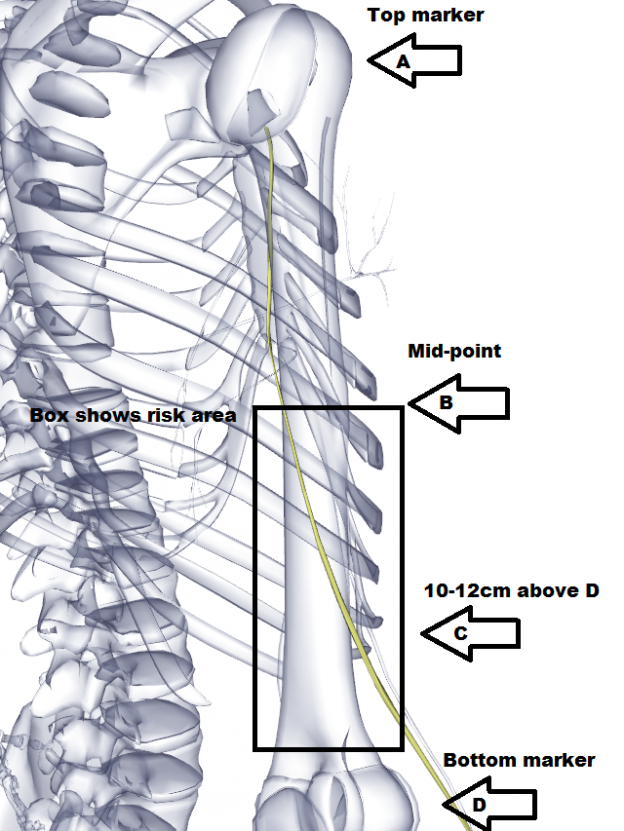
|
|
|
My suggested wrap positioning
The image with musculature shows roughly where I tie most people, indicated in green to represent the wraps. The wraps are at the base of the deltoid and at the top of triceps. This has a further advantage in that your wraps will also lie beneath the should blades. Why does this make sense? Quite simply, it is a strong safe area which can take the load comfortably, safely and with minimal physical distortion under load. The muscles provide a natural anchor point to help stop the rope moving. Importantly, it is offers the smallest diameter in that area. Think what happens if you tie over a wider diameter. Yep, as you load the wrap, it will seek out the smallest diameter and thus you will lose tension. Lose your tension and the tie becomes unstable. If your wraps move unduly, they might end up in the wrong place or, worse, cause a nerve to shear. If you tie too high with somebody with rounder shoulders, there is a risk of the upper wrap slipping off entirely as you are tying 'on the slope'.
On the subject of 'slopes', breast size and height can make a difference. I find a larger breast can make me place my upper wrap too high due to the higher starting point. The other problem is that it might be difficult to keep the wraps sufficiently close, so I can see an argument for adding a 3rd rope. This is something Nina finds when tying the delightfully endowed MaYa.
In summary, my recommendation is to treat the portion of the upper arm below the mid-point with extreme care. The mid-region has the radial exposed on the outside and there's the ulnar lower down. It is my belief that tying closely spaced wraps with the upper on the lower slope of the deltoid is much safer than wide spacing or low bottom wraps. I stress this is a generalisation which will always have its exceptions to catch you out.
I hope this has provided food for thought. I open it up to peer review and would be delighted to hear from anyone who has any views, amendments or additions.
Box-ties, “TKs" and nerve injury
A recent discussion on my Fetlife kinbaku group threw up an interesting misnomer concerning the potential nerve vulnerability on the inner side of the arm. It's quite possible we were talking at cross purposes but since “
The TK" (actually a whole family of ties) is getting some undeservedly bad press, I think it's worth clarifying where nerves are most vulnerable in the upper arm. In my opinion, inner side of the upper arm is one of the two major sites of box-tie suspension injuries (marked A below). In this area, the radial, median and ulnar pass from the spine in a bundle, called the brachial plexus, under the armpit to branch out down the arm. I devised a way to test for radial sensitivity which can be combined with palpating to locate the nerve. I wrote about it here and posted a video.
The other main cause of radial compression is pressure from the lower wraps due to bad placement or movement. You can see the radial run down the inside of the upper arm and spiral around at around the top of the lower third (in the region of B below). You can read more about the vulnerability there from the lower wrap in this article. In short:
- Watch out for bulk, e.g. knots, twists, bunched up clothing, in the upper cinch under the arm
- Never cinch between the back and front of a wrap as this forms a ligature around the arm
- Keep cinch ropes under minimal tension
- Allow upper wrap to lock under shoulder blades and base of deltoid
- Keep lower wrap up and away from the radial
For general upper body information, see my Nerve Damage Study. I strongly recommend study of BioDigital Human which allows exploration of human anatomy via annotated 3D images.
BEWARE!
No two people are the same and you will not be identical to the diagram below. It is essential to be sure where your nerves run and make sure the rigger takes this into account. If he doesn't or the tie fails in its functionality, don't blame the tie. This is like blaming a car manufacturer for accidents resulting from bad driving or inadequate maintenance. However, even a perfect driver in a perfect car can still have an accident. Same rules apply to suspension bondage.
|
Rear view from BioDigitalHuman.com |
Beneath view from BioDigitalHuman.com |
|
Causes of injury
- The radial nerve may be damaged by trauma or entrapped, especially between the heads of muscles.
- In the axilla:
- With features of weak triceps, wrist drop and possibly also median and ulnar nerve involvement. The most common cause is compression.
- The radial nerve may be damaged in the axilla by fracture or dislocation of the head of the humerus.
- Saturday night syndrome (so named because it can be acquired by sleeping with the arm over the back of a chair whilst in a drunken stupor, so compressing the plexus):
- Is due to compression of the lower part of the brachial plexus. As this is really a brachial plexus injury, the median and ulnar nerves may also be involved.
- It may also be compressed by the use of shoulder crutches.
- Nerve function usually fully recovers within a few weeks.
- In the upper arm (triceps and brachioradialis are often spared):
- May be due to a compression lesion but fracture is the usual cause. Injections given in the arm of small babies can damage the radial nerve.
- As the nerve often passes down in the spiral groove of the humerus, it may be injured with a fracture of the shaft of the humerus.
- At the elbow:
- The radial nerve may be entrapped at the elbow at a number of sites but the most common is the proximal border of the tendon of supinator called the arcade of Frohse.
- Check for tenderness over the radial tunnel. There may be pain when the fingers are extended against resistance.
- Supination from a pronated position along with flexion of the wrist may reproduce the symptoms.
- Lesions at the wrist:
- Cause finger drop with a normal wrist and intact sensation.
- Causes include fracture of the radius, elbow deformity, soft-tissue masses and compression by the extensor carpi radialis brevis.
- Lesions of the superficial nerves (cause pain and sensory loss but no motor loss):
- At the elbow, ruptured synovial effusion is the most common cause. In the forearm there may be an aberrant course through the muscles.
- At the wrist, causes include compression from plaster casts, wristbands or handcuffs, especially the type that get tighter with struggling. Other causes are surgery, injections and nerve tumours.
Symptoms
Based on the location of the nerve damage, brachial plexus injuries can affect part of or the entire arm. For example, musculocutaneous nerve damage weakens elbowflexors, median nerve damage causes proximal forearm pain, and paralysis of the ulnar nerve causes weak grip and finger numbness.[7] In some cases, these injuries can cause total and irreversible paralysis. In less severe cases, these injuries limit use of these limbs and cause pain.[8]
The cardinal signs of brachial plexus injury then, are weakness in the arm, diminished reflexes, and corresponding sensory deficits.
See
Brachial Plexus Assessment and Common Injuries for full text of the extracts below.
Sensory nerves:
Pinch the nail base, pull the finger outwards and ask about feeling anything. A burning feeling indicates continuity in the following nerves; absence does not necessarily mean nerve is divided but may be due to neurapraxia instead.
- Thumb – tests the median nerve supplied by C6.
- Middle finger – tests the median nerve supplied by C7.
- Little finger – tests the ulnar nerve suppled by C8.
Motor nerves:
Examination can be made difficult by anomalous nerve distribution, including C4 contributing to the brachial plexus and also because many muscles are supplied by more than one motor neuron. Assessment of loss of motor function at the cervical root:
- C5: shoulder movement in all directions, flexion of elbow (to some degree).
- C6: flexion of elbow, rotation of forearm, flexion of wrist (to some degree).
- C7: mainly a sensory trunk. (Produces generalised loss of movement in the arm, without total paralysis in any given muscle group. Always supplies the latissimus dorsi.)
- C8: extension and flexion of fingers, flexion of wrist, hand movement.
- T1: intrinsic muscles of the hand, eg adduction or abduction of fingers.
Dissection of brachial plexus.
Click to enlarge
Is the gote dangerous?
I should start by saying that there is no such thing as “
The TK" and secondly that many ties that do not fulfill the required function are cited as such in incidents reports leading to an undeserved reputation as a dangerous tie.
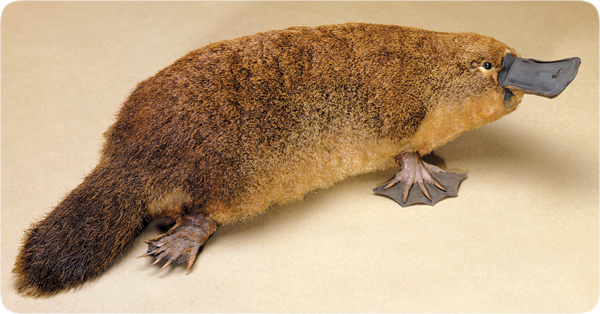
No,I don't fly like a duck
My position is that “
The TK" is an entire family of ties. Indeed, there is some debate whether TK (takate kote) refers only to ties meeting its literal description of 'high hands behind' and should not include parallel arms versions. I suspect this could be a regional difference or even personal preference in Japan but it's not important for this discussion. If I use a Japanese word at all these days, I prefer the more all-encompassing term 'gote'. Let's just agree that for most westerners it means a box-tie of Japanese origin. For many, it means something that just looks like one. It certainly gets used as if it were only one tie and to covers almost anything with two sets of torso wraps encompassing arms and wrists tied. Herein lies the problem, looking like something doesn't make it behave the same. A platypus swims, has webbed-feet and a bill like a duck but it doesn't make it fly like a duck. Neither does it mean ducks have venomous spines. Many so-called TK's don't fly like one either so this functional failure might be the problem, not the tie.
One only has to search Google Images to see the wide interpretation of the term “takate kote": Search results. I hope that even the relatively untrained eye will see that these examples exhibit typical errors, e.g. poor wrap placement likely to cause nerve damage. In fact some are so bad, I'd be hard pushed to place wraps any worse if I was actually trying to cause nerve damage! I shudder to think of the results should an inexperienced rigger use some of these photos as their reference. Effective and accurate practice is paramount. You might think you have the steps off pat but a few days later during practice, mistakes can creep in and, before you know it, be committed to muscle memory. Self-critique, creativity and a better understanding can be achieved if the function is also explained. Not just “Do this!" but why you do it.
There seem to be two views circulating about the safety of these ties. One side believes that this type of tie is inherently dangerous since it encompasses the arms thus creating an inevitable risk of nerve damage.Very often members of this faction show little evidence of the ability to tie any type of box-tie which incorporates the best practices and function of the formal forms taught by the Japanese masters that I have encountered.
The other school of thought maintains, as I do, that a properly tied gote is pretty safe but a liability in unskilled hands when used for suspension. I always draw the parallel of a fast motorcycle. Very few are inherently unsafe but all require some skill, care and training to minimise risk. Bikes will always be more dangerous than cars but the roads will never be safe, not even if we all take to tanks
![]() The risk is in the hands of unskilled users all things being equal .
The risk is in the hands of unskilled users all things being equal .
All I can say is that a lot of professional rope models pass through this house and several I know very well. Injuries seems very rare. If this tie were inherently dangerous they'd be crippled since they perform it almost daily. Why to they remain safe? My guess is they are tied by people who are experts in applying this type of tie. They will give feedback if something isn't right. One should not ignore that they are at the top of their game and pushing the envelope. They know their bodies in rope very well, are young, relatively fit and not overly susceptible to nerve injury.
Accidents happen when confidence exceeds ability, either in terms of skill or physical capability.This is well know as a tendency with new drivers, especially motorcyclists. Accident rates decline rapidly once experience tames rashness. Sadly, it usually takes one or two expensive and painful close encounters with the tarmac to learn this lesson. It has been suggested if the consequences in rigging were a little more personal like this we might take more care but we'll never know.
In my experience, those that hold the opinion that the problem is not the tie tend to be much more purist and Japanese in their style. Most had either attended workshops with acknowledged Japanese master or had attended high level tuition on multiple occasions. Not only have they tied many 100's, if not 1,000's, of gote but some can faithfully reproduce several versions by different sensei and even know the variations within those.
Looking at my own perception of my knowledge over my career, I would say kinbaku is a subject that is like an iceberg. Only 10% is clearly visible. Pretty patterns with jute rope. Once one starts learning, it becomes obvious that is has multiple layers like an onion. I have had several periods in my life where I have naively thought I had begun to know something about this art, only to discover a whole new layer. In short, sometimes you don't know what you don't know. It takes a little learning to appreciate the depth contained in this deceptively simple tie. Not only that, one realises that the whole raison d'etre is different from western bondage. This is embodied in ubiquitous quotes like “the rope is an extension of your hands" and “the rope is a tool of communication".
Many know how Osada Steve and I met but the story might serve as a moral tale for others. Many, many years ago, some bloke emailed me telling me I was talking bullshit on-line about shibari. WTF?! Who was this guy? I'd read Mindori's book so I was an expert! I remained convinced that he was making a big mystique out of nothing just to flog expensive lessons. Roll forward to seeing Japanese bondage as done in Japan and finding out 'this bloke' was Osada Steve who knew a thing or two about this shibari stuff…we kissed, made up, I eventually persuaded him to teach me, the rest is history…I bet I could still spend all week with him and learn things about tying gote/TKs or whatever we have to call them.
This family of ties covers a wide range designed for different purposes. The right engineering is important to achieve the function safely. For example, a typical Yukimura gote is not designed for dynamic suspensions like some of the technical Kanna style 3-rope gote. For the most part, the function of a gote is to keep the bindings in place safely and away from vulnerable nerves and , during suspension, to provide support. This applies whether your box-tie originates from the west, Japan or a far flung galaxy and regardless of what you call it. Obviously, one needs to consider the whole process when trying to optimise safety as the tie cannot be taken in isolation. The person tied, their individual differences and the type of bondage planned are all factors to be considered since it is an holistic exercise. Here, I'm concentrating on aspect of the tie, so we can leave the other factors out of this discussion.
Since safety is the only consideration, we can also ignore any nit-picking over exact authenticity of style as long as function is fulfilled. This really isn't about elitism or being pedantic. I suspect those who bleat about that do so as a smoke-screen for the lack of ability to discuss or analyse the tie meaningfully. Condemnation is easier than discussion. So, whilst an Osada ryu TK might be judged technically wrong with an X-friction on the lower wraps, it is irrelevant, apart from semantically, if that friction does the job. The problem lies when, for example, the correct friction is not compacted so does not fulfill its function and it results in a failure leading to injury. In such cases, it is easier to blame the tie than oneself but the workman should not blame his tools. One might make a fundamental error unknowingly if one has been given the impression that a few minutes demonstration at a rope convention constitutes adequate training. I'm really not sure whether those who perpetuate such myths do so out of ignorance, ego or self-interest.
Anyway, I heard a nice quote upon which I will leave you to meditate “Do not follow the masters, follow what the masters seek".
Mobilization of the Plexus Brachialis Nerve Branch
Mobilization of the Plexus Brachialis Nerve Branch This article also has very useful advice in relation to tying the gote.

